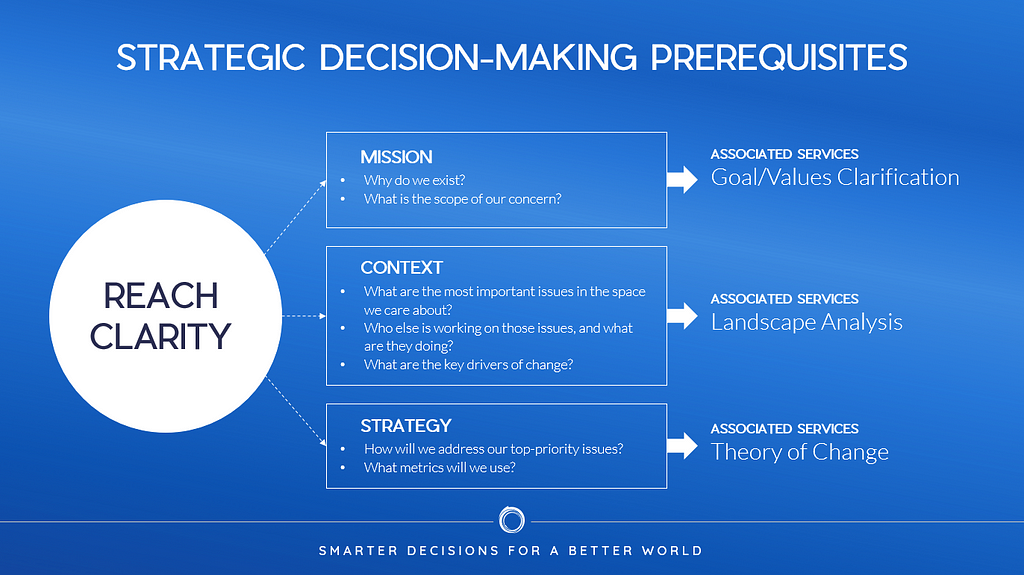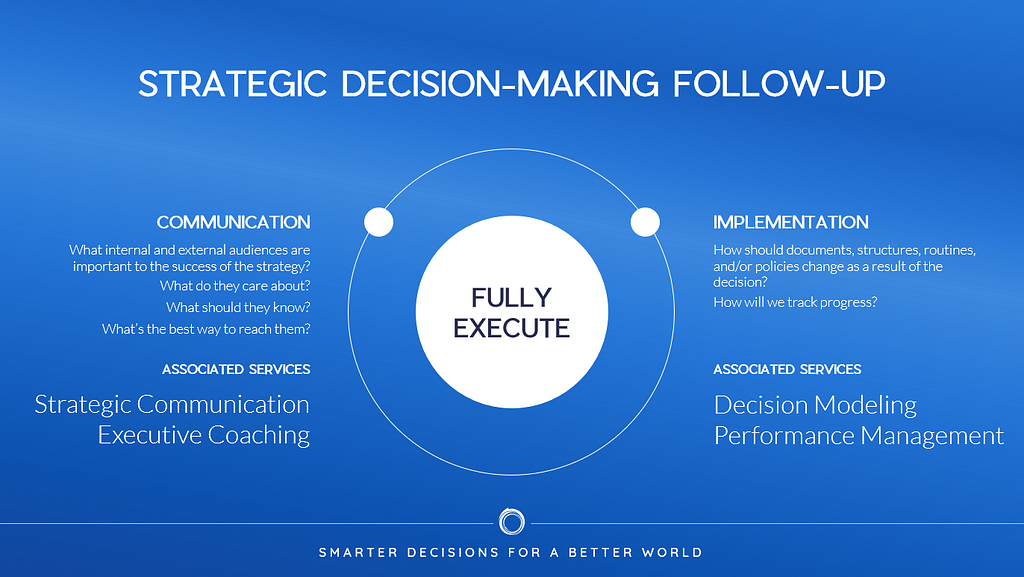Decision-Making for Impact: A Guide
post by Ian David Moss · 2019-09-16T05:12:01.000Z · LW · GW · 0 commentsContents
Begin with strategy Deciding what to decide Breaking down your decision Going mental with decision modeling After the math, the aftermath You, too, can decide like a pro None No comments
The most important decision is how to decide.

For about a decade now, I’ve been geeking out hard on decision-making. To be fair, my fascination comes from an honest place: I’m a walking stereotype of a reluctant decision-maker. Back when I was a teenager, I was paralyzed by challenges as mundane as what topics to choose for my high school English papers. Even now, I drive my wife and other dinner companions crazy whenever we’re at a restaurant, as I’ll study the menu, ask the server for a recommendation, ignore that recommendation, then call them over a minute later and change my order again. (Seriously, this exact sequence happens like 40% of the time.)
The self-help literature these days may be littered with guides on how to give yourself productivity superpowers — use power poses to harness your grit so that that you can enjoy a four-hour work week and retire early! — but personally, I’m more interested in how to give myself the superpower of making consistently wise decisions. Because it doesn’t matter how fast you blow through your task list if it’s full of mindless busywork.
And when it comes to social sector leaders, I’m doubly interested. Because your decisions carry a profound moral weight. They matter. The decisions of government officials, donors, and nonprofit executives have shaped my life in too many ways to count, both for better and for worse. And if you pause to think about your own life, I imagine you’ll conclude the same.
To be honest, I think that’s why we all got into this work in the first place: to make a difference in people’s lives. But it took me a while to realize that the difference we make and the decisions we make are one and the same. Better decisions foster a legacy we can be proud of.
So how can we get better? Lots of ways! Decision-making is an exciting frontier in social impact precisely because there is so much untapped potential to improve how we do things. For decades now, scholars and practitioners have been pioneering methodologies for analyzing and making decisions that have seen barely any adoption in philanthropy, government, or impact investing. Drawing from that body of work, I’ve developed my own process to help myself and my collaborators make critical decisions with intention and focus. Here, I’m sharing the key elements of that process so that you can benefit from them in your own practice.
Begin with strategy
It’s important to place decisions in context. Decision theory can’t tell you what goals ought to be motivating you or who should be accountable for making decisions. So I like to tell people that decision-making doesn’t replace strategy. Instead, decision-making is the manifestation of strategy. Decision analysis methodologies are most powerful when you already have a pretty good idea of what you’re trying to do and how you want to try to do it. They work best when the challenge in front of you is to figure out how to take the general direction and principles you’ve already committed to and translate them into action in this specific situation.
Accordingly, before you make use of the advice in the rest of this article, it’s best to have your mission, vision, and values figured out and committed to paper or pixels. You should know who has final authority for decision-making and, if decisions must be made as a group, how conflicts will be resolved among the group members. And you should ideally have some sense of the landscape in which you’re operating and the specific, near-term outcomes that are most critical to your success.

Now, it might not be immediately clear why anything more than this is necessary. If you’ve already set out a general strategy, won’t its application to day-to-day decisions be straightforward? In some cases, it might be. Not every decision is a head-scratcher, after all. But almost inevitably, tradeoffs come up between goals or values that can’t be accommodated at the same time or to the same degree. Almost inevitably, people on your team or in your brain trust will disagree about the likely consequences of different paths forward, with no easy way to determine who’s likely to be right. And almost inevitably, there will be situations where the right choice will piss off all the wrong people.
Decision analysis was made for moments like these.
Deciding what to decide
We make hundreds of decisions every day, from what to cook for dinner to whether to open up Twitter right now to how to respond to the slightly offensive comment your coworker just made. Most of these are hardly worth a moment’s thought, to say nothing of hiring a consultant to help you figure them out.
If the discipline of decision analysis makes anything clear, though, it’s that some decisions matter more than others. Decisions in which the stakes are high, the context is unfamiliar, and the definition of success is not immediately obvious are the ones that will benefit most from your sustained attention.
Due to the fast pace at which many teams operate, though, we often only start paying attention to decisions shortly before they need to be made. As a result, we shortchange many of our most important decisions and risk falling prey to cognitive biases that lead to worse outcomes.
We can’t afford to thoroughly analyze every single decision we make, of course; we would quickly find ourselves so consumed by the exercise that we are unable to get anything done. So we need some way of anticipating and prioritizing our decisions in order to ensure we are spending the appropriate bandwidth on the ones that really matter.
Fortunately, there is a simple activity called a decision inventory that can fix this problem. Adapted from a method created by decision analysis pioneers Strategic Decisions Group, the decision inventory is a means of cataloguing, consolidating, and sorting all of the major decisions you expect to make in the near to medium term. The exercise offers foresight on what dilemmas you will need to focus on when, and which ones to resolve quickly vs. investigate thoroughly.

Breaking down your decision
Okay, now we’re getting to the good stuff. Once it’s clear which decisions are most deserving of your attention, it’s time to start analyzing the ones on top of the pile. There are a number of ways one could potentially break down a decision into its component parts. My own process incorporates the following:
- The factors at play. What is the broader organizational/strategic context in which this decision is taking place? You and your team members will usually have a strong intuitive sense of what’s relevant here, so it’s fine to rely on your gut for this one as a first pass. What are the biggest opportunities and concerns associated with this dilemma? What most excites and/or worries you?
- What you could do. What are the options on the table? What options should be discussed but aren’t part of the conversation yet? What are the pros and cons associated with each?
- Optimization strategies. Are we making this decision at the right time? Generally speaking, more strategic/consequential decisions should precede more tactical choices. Other decisions would be better considered after some set of events has unfolded or more information will be available. Finally, sometimes it makes sense to “bundle” decisions together so that the strategy can be naturally aligned.
- Stakes. You will have already begun to assess the stakes of a decision at the inventory stage, but it’s helpful to keep them in mind as you determine how much total time and budget you’re willing to spend before committing to a direction. A thoughtful assessment of stakes will take into account who and what could be affected by the outcome(s) of the decision, by how much, and for how long. It would also consider the reversibility of the decision; once you’ve made it, how hard is it to go back on it?
- Sources and degree of uncertainty. If you had to make this decision right now, what choice would you make? If the answer isn’t immediately obvious, it’s probably because there’s something (or several things) you don’t know that you wish you did. Honing in on those sources of uncertainty can help you prioritize what additional information would be most helpful to you in this situation. (Note that you can usually get a much more precise understanding of the value of additional information by modeling the decision quantitatively, as discussed below.)
Don’t be intimidated by the breadth of the above list. Chances are you’re already making these kinds of assessments about your decisions, you’re just not (yet) doing it in a systematic way. This process helps to bring that thinking into the realm of the conscious mind. And in many situations, that can happen with just a couple of meetings and some back-of-the-envelope estimates.
Some decisions really do require careful attention to get right, though. For those, there’s no substitute for an in-depth quantitative model.
Going mental with decision modeling
The preliminary analysis described in the previous section will give you a holistic overview of your decision dilemma, but it optimizes for breadth over depth. It’s like exploring the world by looking at a two-dimensional map — you can see the complete picture, but not all the details.
To achieve both, it’s necessary to model your decision explicitly using mathematical tools. This is like exploring the world from your desktop using a combination of Google Maps and Street View. The map helps you understand the broader context, but you can improve your understanding of the details by zooming in on specific points of interest.
My invocation of technology here is intentional, because building decision models is a technological enhancement to human decision-making. We are leveraging the power and speed of modern computing capacity to help us gain a deeper understanding of our decision dilemma than would be possible using our minds alone. You are still in the driver’s seat — you are still the one who makes the decision, after all — but the mathematical model we create serves as a kind of supercharged coach or advisor.
The nuts and bolts of putting together a decision model are too involved to cover here, but I wrote a handy primer featuring a grantmaking case study if you’re interested in learning more about how to do it.

There are two main reasons to put together a decision model. The first is that it’s possible to get much better precision about the factors at play and which ones are really important. When putting together a decision model, I use a statistical technique called Monte Carlo simulation that dynamically generates thousands of potential futures based on the estimates and assumptions that you provide (and can easily tweak in real time). Developed by nuclear physicists in the middle of the 20th century, Monte Carlo simulations have been empirically tested and shown to yield better judgments than alternative strategies in real-world settings. It’s the method that NASA swears by when preparing for so-called “complex projects” like launching human beings into space.
The second awesome superpower of quantitative models is that they can help guide a research or learning agenda created for the express purpose of reducing uncertainty about important factors relating to the decision in question. You can use the concept of value of information to pick out the most important things to measure, measure them, and re-run the model in an iterative cycle until there is literally no more value to wring out of seeking further data. This method is called Applied Information Economics and was invented by information scientist Doug Hubbard for use in high-stakes investment decisions in the social sector and business world alike (read about a couple of examples of its use here and here). As far as decision analysis techniques go, AIE is pretty much the gold standard approach.
With that said, modeling does have some costs and drawbacks. The main challenge is that, compared to the quick and easy process described in the previous section, modeling does usually require a more significant minimum investment of time and expense, an investment that scales with the number of stakeholders that need to provide input. In addition, modeling may feel somewhat intimidating or unnatural at first to staff or partners who have little experience with quantitative methods. Finally, while I’m a firm believer that anything worth modeling can be modeled, it is true that some kinds of goals and decision factors are harder to translate into mathematical terms than others and may require more specialized expertise.
So when should you make the leap to modeling your decision? Ultimately, it comes down most of all to the stakes of the decision. Although all such situations should be judged case by case, a good-enough rule of thumb is that if your decision has more than $25,000 (for an individual) or $50,000 (for an organization) riding on it, it’s worth considering putting together at least a quick-and-dirty quantitative model to help ensure you get it right. And if the stakes are in the $250,000 and up range, I’d say it’s actually pretty irresponsible not to attempt a quantitative treatment of the situation.
Finally, remember: the math is there to help you make your decision, not to make it for you. You are free to ignore it if you want. When I’m making a decision model I work hard to make sure it accounts for everything the decision-maker cares about. But I never deliver a recommendation without also considering the qualitative analysis that we developed alongside it.
After the math, the aftermath
Congratulations, you’ve made your decision! Give yourself a pat on the back and a well-deserved breather. But don’t take too long, for while the dilemma itself may be resolved, the consequences of your choice are just beginning to be felt.
Here are some helpful questions to ask and things to think about in the post-decision phase:
- How should you talk about this decision (and the process that went into it)? Strategic Decisions Group’s Decision Quality framework notably includes “commitment to action” as one of six key pillars to a high-quality decision — meaning that they include commitment in the very definition of what constitutes a high-quality decision. Particularly when the decision is about a charged topic or conversation in your organization or community, having a robust, transparent process like this one can help to build consensus and buy-in moving forward.
- Do you expect to make similar decisions like this in the future? If so, it’s likely you can reuse much of the analysis and basic framework you developed for this one in those scenarios to come. And if you created a quantitative model for the decision, you can turn that model into a standardized template that can accommodate any such situation in the future. In my own practice, I’ve built templates like this for things like whether to apply for a new consulting opportunity. In such situations, the work you put in initially to develop the model is amortized across many uses, making the investment of time effectively a no-brainer.
- How does this decision affect other decisions you need to make? Decisions usually beget more decisions. You or your team might have been waiting for resolution on this situation because it would provide crucial information for other dilemmas in play. In other cases, a decision to, say, move forward with a project will create lots of new choices about how exactly to implement it. Be sure to document the more important of these so that you can devote the appropriate amount of attention to them, and if any seem especially high-stakes and/or uncertain, the techniques discussed in this article are here to help.

You, too, can decide like a pro
So that’s how I help clients make decisions. If you have grappled with how to make smarter decisions for your organization or philanthropy and come up with similar or different techniques, I’d love to hear from you. There is always more to learn, and we are all in this together.
Happy decision-making!
0 comments
Comments sorted by top scores.